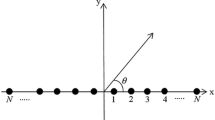Abstract
Linear antenna array (LAA) design is a classical electromagnetic problem. It has been extensively dealt by number of researchers in the past, and different optimization algorithms have been applied for the synthesis of LAA. This paper presents a relatively new optimization technique, namely flower pollination algorithm (FPA) for the design of LAA for reducing the maximum side lobe level (SLL) and null control. The desired antenna is achieved by controlling only amplitudes or positions of the array elements. FPA is a novel meta-heuristic optimization method based on the process of pollination of flowers. The effectiveness and capability of FPA have been proved by taking difficult instances of antenna array design with single and multiple objectives. It is found that FPA is able to provide SLL reduction and steering the nulls in the undesired interference directions. Numerical results of FPA are also compared with the available results in the literature of state-of-the-art algorithms like genetic algorithm, particle swarm optimization, cuckoo search, tabu search, biogeography based optimization (BBO) and others which also proves the better performance of the proposed method. Moreover, FPA is more consistent in giving optimum results as compared to BBO method reported recently in the literature.














Similar content being viewed by others
References
Balanis C (1997) Antenna theory-analysis and design, 2nd edn. Wiley, New York
Merad L, Bendimerad F, Meriah S (2008) Design of linear antenna arrays for side lobe reduction using the tabu search method. Int Arab J Inform Technol 5(3):219–222
Khodier MM, Christodoulou CG (2005) Linear array geometry synthesis with minimum side lobe level and null control using particle swarm optimization. IEEE Trans Antennas Propag 53(8):2674–2679
Khodier M, Al-Aqeel M (2009) Linear and circular array optimization: a study using particle swarm intelligence. PIER B 15:347–373
Recioui A (2011) Sidelobe level reduction in linear array pattern synthesis using particle swarm optimization. J Optim Theory Appl 153(2):497–512
Rattan M, Patterh MS, Sohi BS (2007) Synthesis of aperiodic liner antenna arrays using genetic algorithm. In: 19th international conference on applied electromagnetics and communications, ICECom—2007, pp 1–4
Cengiz Y, Tokat H (2008) Linear antenna array design with use of genetic, memetic and tabu search optimization algorithms. Prog Electromagn Res C 1:63–72
Lin C, Qing A, Feng Q (2010) Synthesis of unequally spaced antenna arrays by using differential evolution. IEEE Trans Antennas Propag 58(8):2553–2561
Dib N, Goudos S, Muhsen H (2010) Application of Taguchi’s optimization method and self-adaptive differential evolution to the synthesis of linear antenna arrays. PIER 102:159–180
Singh U, Kumar H, Kamal TS (2010) Linear array synthesis using biogeography based optimization. PIER M 11:25–36
Sharaqa A, Dib N (2013) Design of linear and elliptical antenna arrays using biogeography based optimization. Arab J Sci Eng 39(4):2929–2939
Singh U (2013) Simulation and optimization of antennas using stochastic methods. Ph.D. Dissertation, Punjab Technical University, Jalandhar, India
Rajo-Iglesias E, Quevedo-Teruel O (2007) Linear array synthesis using an ant colony optimization based algorithm. IEEE Antennas Propag Mag 49:70–79
Pal S, Qu B-Y, Das S, Suganthan PN (2010) Optimal synthesis of linear antenna arrays with multi-objective differential evolution. PIER B 21:87–111
Goudos SK, Moysiadou V, Samaras T, Siakavara K, Sahalos JN (2010) Application of a comprehensive learning particle swarm optimizer to unequally spaced linear array synthesis with side lobe level suppression and null control. IEEE Antennas Wirel Propag Lett 9:125–129
Chowdhury A, Giri R, Ghosh A, Das S, Abraham A, Snasel V (2010) Linear antenna array synthesis using fitness adaptive differential evolution algorithm. In: Proceedings of the international conference on evolutionary computation. IEEE Press Barcelona, Spain, pp 3137–3144
Guney K, Onay M (2011) Optimal synthesis of linear antenna arrays using a harmony search algorithm. Expert Syst Appl 38(12):15455–15462
Singh U, Rattan M (2014) Design of linear and circular antenna arrays using cuckoo optimization algorithm. PIER C 46:1–11
Khodier M (2013) Optimisation of antenna arrays using the cuckoo search algorithm. IET Microw Antennas Propag 7(6):458–464
Guney K, Durmus A (2015) Pattern nulling of linear antenna arrays using backtracking search optimization algorithm. Int J Antennas Propag. doi:10.1155/2015/713080
Babayigit B, Akdagli A, Guney K (2006) A clonal selection algorithm for null synthesizing of linear antenna arrays by amplitude control. J Electromagn Waves Appl 20(8):1007–1020
Guney K, Babayigit B (2008) Amplitude-only pattern nulling of linear antenna arrays with the use of an immune algorithm. Int J RF Microw Comput Aided Eng 18(5):397–409
Guney K, Babayigit B, Akdagli A (2007) Position only pattern nulling of linear antenna array by using a clonal selection algorithm (CLONALG). Electr Eng 90(2):147–153
Yang XS (2012) Flower pollination algorithm for global optimization. In: Durand-Lose J, Jonoska N (eds) International conference on unconventional computing and natural computation. Springer, Berlin, Heidelberg, pp 240–249
Chakravarthy Vedula VSSS, Chowdary Paladuga SR, Rao Prithvi M (2015) Synthesis of circular array antenna for sidelobe level and aperture size control using flower pollination algorithm. Int J Antennas Propag. doi:10.1155/2015/819712
Sharawi M, Emary E, Saroit IA, El-Mahdy H (2014) Flower pollination optimization algorithm for wireless sensor network lifetime global optimization. Int J Soft Comput Eng 4(3):54–59
Alam D, Yousri D, Eteiba M (2015) Flower pollination algorithm based solar PV parameter estimation. Energy Convers Manag 101:410–422
Abdelaziz A, Ali E, Abd Elazim S (2016) Flower pollination algorithm to solve combined economic and emission dispatch problems. Eng Sci Technol Int J 19(2):980–990
Bekdaş G, Nigdeli S, Yang X (2015) Sizing optimization of truss structures using flower pollination algorithm. Appl Soft Comput 37:322–331
Oily Fossils provide clues to the evolution of flowers, Science Daily. (2001). http://www.sciencedaily.com/releases/2001/04/010403071438.htm
Walker M (2009) How flowers conquered the world. BBC Earth News. http://news.bbc.co.uk/earth/hi/earthnews/newsid8143000/8143095.stm
Glover B (2007) Understanding flowers and flowering: an integrated appraoch. Oxford University Press, Oxford
Waser N (1986) Flower constancy: definition, cause, and measurement. Am Nat 127(5):593
Pavlyukevich I (2007) Levy flights, non-local search and simulated annealing. J Comput Phys 226:1830–1844
Author information
Authors and Affiliations
Corresponding author
Rights and permissions
About this article
Cite this article
Singh, U., Salgotra, R. Synthesis of linear antenna array using flower pollination algorithm. Neural Comput & Applic 29, 435–445 (2018). https://doi.org/10.1007/s00521-016-2457-7
Received:
Accepted:
Published:
Issue Date:
DOI: https://doi.org/10.1007/s00521-016-2457-7




